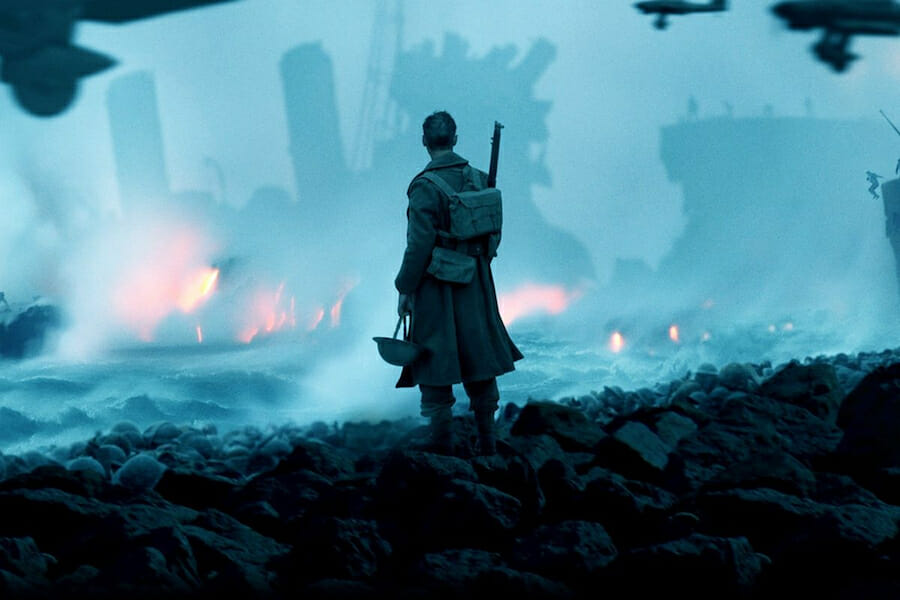
‘Dunkirk’ Review
Even for us frequent movie-goers, a truly great film is a rare and emotional experience. Leave it to Christopher Nolan, one of the finest film makers working today, to deliver a World War II masterpiece centered on a remarkable and historic evacuation, rather than one of the epic battles that more directly led to an Allied victory. The result is a spectacular, stunning and relentlessly intense assault on our eyes, ears & emotions…Dunkirk’s a horrific thing of artistic beauty.
Mr. Nolan chooses a triptych approach to tell the May/June 1940 Dunkirk story from three distinctly different perspectives: The Mole, The Sea, and The Air. The Mole (term for protective sea walls) is the “by land” segment, and it shows nearly 400,000 soldiers lined up on the beach – nervously waiting to be either rescued or massacred. The Sea puts us not on the deck of the Navy destroyers, but rather alongside the citizen volunteers who answered the call to ferry men off the beach with their own pleasure vessels. The Air situates us inside the Spitfire cockpits of two Royal Air Force pilots battling low fuel as they attempt to protect their fellow soldiers below. This 3-part film harmony expertly captures the disorientation of war by shuffling between the three segments & by varying the timelines and sequence of each.
The events at Dunkirk happened pretty early in the war; Winston Churchill had only become Prime Minister a few weeks prior. It should be noted that Mr. Nolan purposefully avoids the usual war room blustery (we see neither Churchill nor Hitler, and there is little mention of the infamous Halt Order). Instead, his focus on the (very) young men being sent to battle makes a clear political statement on the absurdity of war. One of “The Sea” volunteers (an excellent Mark Rylance) delivers the message when he states it’s the old men running the war, so he can’t be expected to just sit back as young sons are sent to fight and die.
Despite the epic look, feel & sound of the film and the massive scale of the event, this film is surprisingly at its best in the small moments of heroism and the dogged determination of individuals to survive. Minimal dialogue allows the horrors of war to take center screen. Danger and death are at every turn – bombings, torpedoes, drowning, gunfire, and most any imaginable peril is ever-present. We witness PTSD (shell-shock) in the form of Cillian Murphy’s shivering rescued soldier, and are reminded that every young man present will be either dead or scarred for life. No one escapes war unscathed.
Dunkirk’s opening sequence finds a young soldier named Tommy (Fionn Whitehead) and his squad being targeted with gunfire as German leaflets fall from the sky. The film is meticulously researched and historically based, though the few characters we get to know are fictionalized. The practical effects throughout are breath-taking and much of it was filmed on location at the beach of Dunkerque. The technical aspects of the film are beyond reproach – although the French might have preferred that their military receive a bit more attention. Hans Zimmer’s score is unique and searing as it perfectly captures the intensity of the film; his use of a ticking watch perpetuates the constant, ominous feeling of running out of time. Cinematographer Hoyte Van Hoytema and Editor Lee Smith prove why they are among the best at their profession.
Given the spectacle of the action (if possible, see it in IMAX or 70mm), it’s remarkable how we still manage to get to know some of the characters. From The Mole segment, Fionn Whitehead, Aneurin Barnard and Harry Styles portray youthful soldiers, while Kenneth Branagh and James D’Arcy play officers. Tom Hardy and Jack Lowden are Spitfire pilots, while Mark Rylance, Barry Keoghan, Tom Glynn-Carney, and Cillian Murphy are manning the rescue yacht. Nolan regular and good luck charm Michael Caine can be recognized as the voice on Air Force radio.
The horrors and impact of World War II continue to be an abundant garden – ripe for the picking when it comes to movies. Over the past 70 years there have been numerous approaches to telling different parts of the story that redefined the world: Judgment at Nuremberg (legal aftermath), Casablanca (romance), I Was a Male War Bride (comedy), Tora! Tora! Tora! and From Here to Eternity (Pearl Harbor), Shoah (documentary), Schindler’s List and Son of Saul (Holocaust), Downfall (Hitler), The Great Escape (entertainment), Patton (bio), The Pianist (personal), Saving Private Ryan (Normandy), Das Boot (U-boat), The Thin Red Line (Guadalcanal) & Letters From Iwo Jima (two opposing perspectives). Christopher Nolan’s film belongs among the best.

